
The hornet moth or hornet clearwing is a large moth native to Europe and the Middle East and has been introduced to North America. Its protective coloration is an example of Batesian mimicry, as its similarity to a hornet makes it unappealing to predators. The hornet moth has been linked to the large dieback of poplar trees across Europe because its larvae bore into the trunk of the tree before re-emerging as adults.

Paranthrene tabaniformis, the dusky clearwing, is a moth of the family Sesiidae. It is found in the Palearctic and Nearctic realms.

Sesia bembeciformis, the lunar hornet moth, is a moth of the family Sesiidae. It is found in Europe.
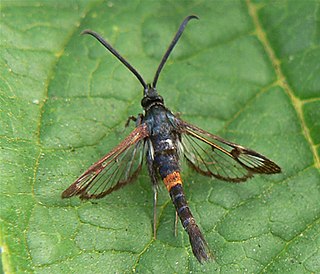
Synanthedon myopaeformis is a moth of the family Sesiidae and the order Lepidoptera. In Europe it is known as the red-belted clearwing and in North America as the apple clearwing moth. The larvae create galleries under the bark of fruit trees, especially old trees with damaged trunks. During this process, the larvae cause significant damage to host trees. Particular attention has been paid to the damage they cause to apple trees. Their status as a pest of apple orchards has led to many research projects aimed at controlling populations of the moth. This moth is native to Europe, the Near East and North Africa. Recently, the moth was introduced into North America, being first detected in Canada in 2005. There are several organisms that threaten the larvae, including parasitoids, nematodes, and bacteria.

Synanthedon spheciformis, the white-barred clearwing, is a moth of the family Sesiidae. It is found in Europe and Siberia.

Synanthedon tipuliformis, known as the currant clearwing, is a moth of the family Sesiidae. It is endemic to the Palearctic realm, but is an invasive species in the Nearctic realm and the Australasian realm.

Synanthedon vespiformis, the yellow-legged clearwing, is a moth of the family Sesiidae. It is found in the Palearctic realm.

Synanthedon decipiens, the oakgall clearwing or oak gall borer, is a moth of the family Sesiidae. It is found in eastern North America.
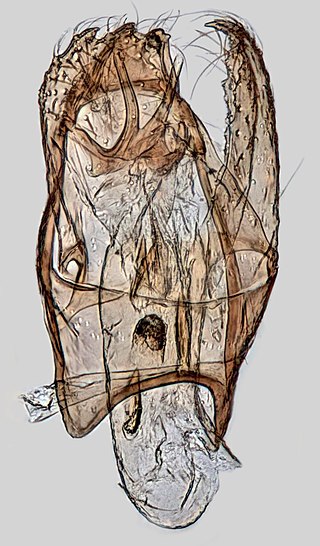
Stigmella obliquella is a moth of the family Nepticulidae which feeds on willow and can be found in Asia and Europe. It was first described by Hermann von Heinemann in 1862.
Ichneumenoptera chrysophanes, the clearwing persimmon borer, is a moth of the family Sesiidae. It is found from Cairns in Queensland to Canberra in the Australian Capital Territory.

Synanthedon andrenaeformis, the orange-tailed clearwing, is a moth of the family Sesiidae. It is known from most of Europe. It is also present in the Near East. The wingspan is 18–22 mm. Adults are on wing between May and June in western Europe.
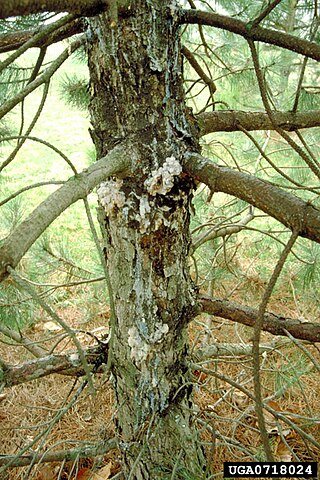
Synanthedon pini, the pitch mass borer, is a moth of the family Sesiidae. The pitch mass borer occurs on spruce and pine in eastern North America. It does not kill trees, but the pitch-filled larval tunnels in the wood cause defects in the lumber.

Synanthedon rileyana, the horsenettle borer or Riley's clearwing moth, is a moth of the family Sesiidae. It is found in the United States, including Arkansas, Arizona, Missouri, Oklahoma, North Carolina and Pennsylvania.
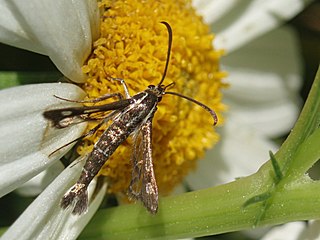
Pyropteron muscaeforme, the thrift clearwing, is a moth of the family Sesiidae. It is known from most of Europe.

Synanthedon cephiformis is a moth of the family Sesiidae. It is found in Central Europe and Eastern Europe.
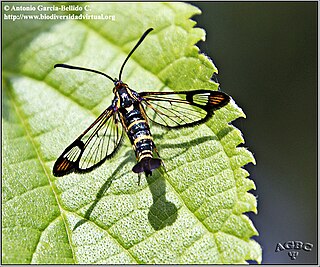
Synanthedon conopiformis, Dale's oak clearwing, is a moth of the family Sesiidae. It is found in almost all of Europe, except the north.
Synanthedon flaviventris, the sallow clearwing, is a moth of the family Sesiidae. The larvae form pear-shaped galls on sallows.

Synanthedon scoliaeformis, the Welsh clearwing, is a moth of the family Sesiidae. It is found from almost all of Europe, east through Russia to Japan.

Synanthedon spuleri is a moth of the family Sesiidae. It is found from France to Turkey and Georgia. In the south, it is found in southern and eastern Europe. In the north, the range extends to the line Paris-southern Germany.
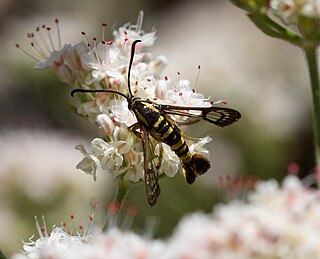
Synanthedon resplendens, also known as the sycamore borer moth, is species of a clearwing moth native to western North America. Larva of this moth live under the bark of sycamore, ceanothus, coast live oak, and, on rare occasions, avocado trees. Sycamore hosts include California sycamore, Arizona sycamore, and American sycamore trees. Coast live oak is a confirmed host, but this moth likely uses many or most other western oaks as well.
Content in this edit is translated from the existing German Wikipedia article at de:Synanthedon formicaeformis; see its history for attribution.



















